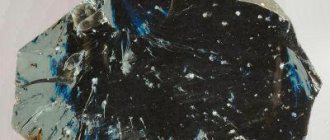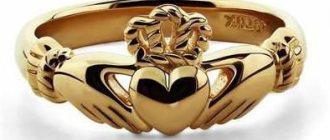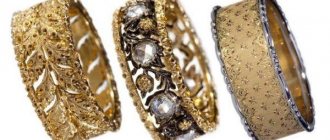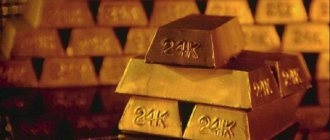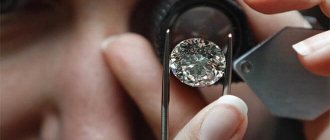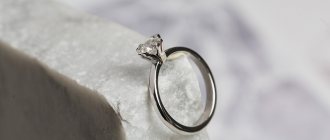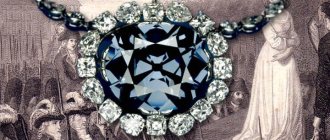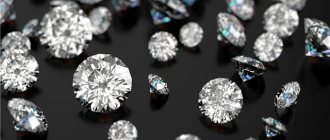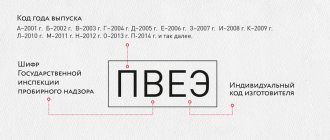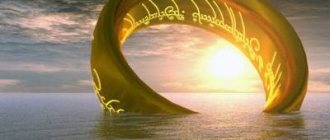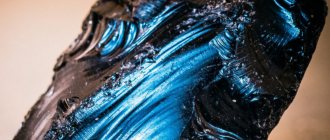If you have purchased a piece of diamond jewelry and doubt that it is real, or are just planning to purchase it, it will not hurt to know how authenticity is checked. Affordable home tests will dispel or confirm suspicions and reduce the likelihood that under the guise and price of a diamond you will be sold a sparkling cheap fake.
What does a real diamond look like?
The most popular, prestigious, expensive and promoted stone is the diamond. Every woman (and some men) dreams of him. The natural raw material for making diamonds is diamonds. They are mined from deposits.
Such crystals have an inconspicuous appearance and irregular configuration. For an ignorant person, this is an inconspicuous stone that does not at all resemble a luxurious sparkling diamond.
A diamond is made of pure carbon, but sometimes it contains impurities of other substances that were around while it was in the ground. The fewer foreign inclusions found in a diamond, the higher its purity. Samples without large inclusions, defects, or cracks are sent to jewelers for processing. To become a full-fledged diamond, the diamond must weigh at least 0.29 carats.
The content of other chemical elements gives diamonds their color. Today, pink, yellow, and blue diamonds are in fashion, but colorless specimens are most valued.
After the jeweler cuts, grinds and polishes the diamond, it becomes a luxurious diamond with the following properties:
- Unsurpassed hardness. The diamond can withstand pressure of several tons. It cannot be scratched. Only another diamond can leave a mark on it. Its hardness is 10/10 on the Moss scale (for gold this figure is 3/10).
- Fragility. "A Girl's Best Friend" doesn't pull any punches. If you hit a diamond hard with a hammer, the stone will crack just like glass.
- High refractive index. When light hits a diamond, the stone flashes with myriads of silvery sparks. Due to strong refraction, the diamond does not shimmer with multi-colored highlights, but scatters a noble glow consisting of shades of gray.
- Dispersion or “play of the stone”. According to this indicator, the diamond is a recognized record holder. No other gemstone produces such intense shine.
- Luminescence. In ultraviolet light, the diamond glows with a soft blue glow.
- Resistant to acids (except hydrofluoric acid).
- Withstands high temperatures. The stone will burn if heated to 850 °C or higher.
- Does not change color or fade. And in a hundred years it will shimmer and shine.
Information about the main qualities of a diamond will help you independently distinguish a diamond from a semi-precious stone if you cannot check it with a jeweler.
Real diamonds look like this:
- Faceted stone. If it is unframed, it is accompanied by a certificate confirming its authenticity and quality. If the stone is inserted into the product, then the name (br), clarity (evaluated by four parameters, most often it is 2/4), carat (for example: 1 ct), cut type (cr - round, o - oval) is written on the tag and so on).
- Shimmers and shines. In the light, the stone sparkles with all its facets. This is its distinctive property, which is reflected in the name. Translated from French, “brilliant” means brilliant.
- Has an invisible cut. If it is inserted into a piece of jewelry, it is impossible to see its top and cut angles.
- Sparkles in shades of grey.
- Does not wobble, securely fixed in the product.
- Set in gold or platinum.
- Doesn't shine through. In a properly cut diamond, the bottom is not visible.
- There must be a hole under the stone. The lower part of the diamond (pavilion) should not come into close contact with the metal, because refraction is determined by the stone-air parameter, not the stone-metal parameter.
- Store-bought diamonds often have a round shape and a classic cut of 57 facets.
A black diamond is expensive, but looks less impressive.
It does not play in the light, but only gives an aristocratic glow from the dark surface.
Diamonds as they are
Diamonds are cut gem quality diamonds. This means that they are large enough (from 0.1 carats), transparent, have a minimum of flaws and are suitable for cutting, that is, they can be used for the production of jewelry.
During cutting, a diamond loses at least half its weight. There are special programs that allow you to choose the optimal cutting method for a particular specimen.
Chemically, diamonds are pure carbon, that is, they are close relatives of ordinary graphite (as in a simple pencil). However, over millions of years, under favorable conditions, carbon undergoes a magical transformation, turning into a transparent sparkling mineral of wondrous beauty. It is the hardest substance on Earth and is considered the standard on the Mohs scale.
Diamond is not such a rare mineral, but gem-quality stones are rare, which determines their fabulous cost. Small and cloudy diamonds are widely used in industry, for example, in the creation of cutting tools.
Diamonds are mined on almost all continents except Antarctica. Rich deposits have been discovered in Africa (Botswana, South Africa, Angola), Canada and Russia. At the moment, Russia is the recognized leader in the extraction of gem-quality minerals. Yakut diamonds are famous throughout the world!
The world's diamond reserves are gradually depleting. Their replenishment is not expected, because the age of natural minerals ranges from 100 million to several billion years!
What can it be easily confused with?
A diamond in a piece can be replaced not only at the jewelry manufacturing stage, but also in a jewelry salon. Counterfeits have been used for a long time; they existed back in 1920. In the past, they tried to pass off radiant or corundite as a diamond. Later, other cheap imitators of the “royal stone” appeared - strontium, rutile, titanium, white sapphire.
Modern technologies have made it possible to create artificial stones that are absolutely identical in appearance to processed diamonds. They are made of such high quality that even testers are not always able to recognize a glass diamond.
The properties of a gemstone are best imitated by the following fakes:
- Cubic zirconia (zircon) is a synthetic stone, zirconium dioxide. It was invented by Soviet physicists in the 70s of the last century. Since then, products with cubic zirconia have been sold all over the world. Zircon shines almost as brightly as a diamond, but with iridescent highlights. It can be transparent (the most expensive) and colored. Currently, cubic zirconia is produced in six main colors.
- Moissanite is carborundum, the most accurate artificial copy of a diamond. It is 90% similar to the precious “prototype”. Its shine is even more intense than that of the “king of stones”. It is impossible to identify moissanite by eye; even an experienced jeweler can make a mistake. Not all testers are up to this task.
- Rock crystal is similar in appearance to a diamond, and after cutting it acquires a dazzling shine. You can recognize an imitation by the following characteristics: rock crystal is set in silver, less often - in gold, a diamond is set only in platinum and gold. Glue is often used to fix crystal, but this is not done when working with diamonds.
The following are also sold under the guise of a processed diamond:
- white topaz;
- yttrium aluminum garnet;
- leucosapphire;
- white beryl;
- artificial diamond;
- transparent spinel;
- rhinestones (ornamental stones made of glass);
- combinations of synthesized stones.
What is cubic zirconia?
This is an artificial and relatively cheap material, very similar to a gemstone in appearance, but differing in properties. Its production is a rather difficult and painstaking process, but it cannot be compared in complexity to high-quality cutting of a diamond.
The price per gram of good cubic zirconia reaches $5.
The artificial mineral received its name from the Physical Institute of the Lebedev Academy of Sciences (FIAN). It was there that it was synthesized by a team of Soviet scientists in the 1970s. It is noteworthy that the goal of the project was to obtain a substance with special optical properties suitable for creating laser equipment.
Artificial stone has several names. Chemists know it as zirconium dioxide. In the West, it is more often called zirconite, jewellite or daimonstone.
The invention of Soviet scientists caused a real sensation among both fashionistas and jewelers. Compared to a diamond, this stone was worth pennies. In 1990, 50,000,000 carats of cubic zirconia were produced, and this is an astronomical amount. Every year the pace of production is accelerating, and more and more synthetic gems are entering the markets.
Professional authentication methods
A purchased diamond can be checked for authenticity (for a fee) by a jeweler in a workshop or salon that sells items made of precious metals. For express analysis, a diamond detector is used. The check takes 8-10 minutes.
Outdated models of such devices only examine the thermal conductivity of the mineral, and therefore do not always provide reliable information about the authenticity of the stone. This tester will not help identify moissanite because it has the same thermal conductivity as a diamond.
Professional jewelers who specialize in working with diamonds use an advanced diamond authentication tester. He studies the refraction of light. In this indicator, moissanite is ahead of diamond, which makes it possible to immediately detect a fake diamond.
The diamond tester only tests cut crystals.
Such a device will not be able to examine a rough diamond and determine its authenticity.
The most accurate result is guaranteed by the use of three sensors that analyze reflectance, luminescence and photoluminescence. Inexpensive diamond testers give a 50/50 result - “either a diamond or not.” Such devices cannot be trusted.
Experienced jewelers are able to identify a diamond without the use of technology. To distinguish a diamond from a semi-precious imitation or glass, they examine the stone using the following criteria.
Light
Diamonds have special optical properties that are easy to detect by visual inspection in the light or using a magnifying glass with 10x magnification:
- They give the same intense shine not only from above, but from all sides.
- In directed light they scatter with silvery reflections.
- Opaque. Light falling on a smooth surface of a stone is reflected from the edges.
If you look at the stone from above, you will see many iridescences and a tiny dot in the middle - a thorn. There is a simple way to check this property: draw a letter on a piece of paper and try to see it through the mineral. If it's a diamond, you won't see anything.
Comparison
To distinguish a genuine diamond from other stones, it is enough to know a few basic differences:
- A real diamond is a natural formation; it is never absolutely pure. Looking at it through a magnifying glass, you will definitely see the smallest imperfections in it. If the stone has a perfectly smooth and even surface, you have an artificial analogue.
- A cut diamond sparkles and shimmers so much that other stones appear inexpressive and faded against its background. However, it is difficult to distinguish a stone by this indicator. Some artificially synthesized minerals (moissanite) can sparkle no worse than diamonds.
- Diamond is a record holder for strength; after processing, its edges become sharp and clear. In glass imitators they are less sharp and somewhat rounded.
Distortion
A natural diamond does not exhibit double refraction. If you shine light on it and look through a magnifying glass, you will notice that a direct light beam is reflected from its edges. It never splits in two or deviates to the side. If it turns out that one face reflects two rays (flat and inclined), it is cubic zirconia.
Weight
A reliable method that jewelers have long used to assess the authenticity of diamonds is weighing on a carat scale. It is based on the fact that the size of the stone must correspond to the carat weight. It is known that zircons are half as heavy as diamonds, so a fake will be immediately detected.
The weight of precious stones is expressed in carats: 1 ct = 0.2 g. For example: small diamond: 2.0 mm = 0.029 ct; medium: 3.0 mm = 0.098 ct, 5 mm = 0.450 ct; large: 6.5 mm = 1.010 ct, giant at 9 mm = 2.59 ct.
Frame
A diamond is an elite stone, so jewelers are very meticulous about setting it in a product. Depending on the frame, it appears larger or smaller. The frame allows you to hide minor defects and foreign inclusions. Metal, setting and setting are factors that will help distinguish a real cut diamond from a budget fake.
When purchasing diamond jewelry, check it for compliance with the following rules:
- High purity diamonds are usually set in platinum or white gold. It is believed that white metal does not distract attention from the luxurious stone, but only highlights the brilliance and luxury.
- Colored diamonds are set in red or yellow gold. It harmoniously combines with fantasy stone.
- Silver frames are not elite enough and expensive. Cut diamonds are inserted only into jewelry made of precious metals - gold and platinum.
- A diamond is set in one of three ways. A popular type of fastening is using tiny metal claws (prongs). Blind fastening is a reliable method of encrusting products with diamonds, but it visually reduces the size of the mineral. Much less common is corner setting, when the stone is inserted not into a prepared socket, but into the metal plate itself. Other fastening methods are also used, but the underside of the stone is always left open. If the stone is fastened carelessly (loose, too recessed into the frame, the distances between adjacent paws are not the same) - it is not real. Diamonds are not treated this way.
- No adhesive setting is used for natural stones. Artificial crystals are “planted” on the glue.
To make sure the stone is set in platinum or white gold and not silver, check the hallmark of the metal.
Ultraviolet
A more accurate method that will distinguish a diamond or a cut diamond from inexpensive counterparts of artificial origin is based on the use of ultraviolet light. If you have a quartz medical or ultraviolet lamp at home (for drying gel polish), shine it on the stone and evaluate the result:
- Under ultraviolet light, diamonds emit a bluish glow.
- If the stone does not react to exposure to UV rays, it is glass or another imitation diamond.
- The appearance of a green, gray or yellow glow indicates moissanite.
Diamonds have another specific feature - they are invisible in X-rays. But this property cannot be tested at home.
Diamond
Before getting into the details, you can first look at a photo of what a diamond and cubic zirconia look like.
The refractive index of cubic zirconia is close to that of a diamond, which makes it difficult to determine how to distinguish it from a diamond. This similarity, of course, is actively used by scammers who seek to present jewelry with cubic zirconia as expensive diamond jewelry. After all, the average user is unlikely to be able to distinguish stones from each other.
Therefore, knowledge of how to determine the authenticity of cubic zirconia is useful information that can save a lot of money.
Let's consider the options:
- If possible, it is worth looking through the stone. A diamond will not allow you to see light; you will notice a luminous point, while cubic zirconia allows it to pass through well. You can do a simple test. You need to put paper with printed text, if it can be read through the stone, then you are holding cubic zirconia in your hands. This simple method will allow you to distinguish stones at home.
- There is another, even more affordable option. You need to take the stone in your hand and hold it for a while. Cubic zirconia will be at ambient temperature, while diamond will always be cool despite the warm air.
- You can also breathe on the stone; cubic zirconia will fog up, but a diamond will not.
- Another determination method can be used, but it has certain implementation difficulties. And that's why. You should smear the stone with oil and then apply it to the surface of the glass. Sticking will only be observed if you are dealing with a diamond.
- If you pay attention to the edges, the diamond has sharper edges. You can look for small defects that, oddly enough, are characteristic of a diamond. The stone in question has an ideal surface.
- There is one more option left, the most impractical, since it allows you to find out the truth only after some time. If, after wearing, a stone loses its shine or becomes damaged, the answer to what kind of stone it is is obvious. After all, diamond has the highest hardness.
All that remains is to make a final conclusion. If you are not sure what is in front of you, then you can do something simple: take the product to a professional for evaluation. He will help put all the dots in this matter.
How to distinguish a diamond from a fake at home
To independently verify the authenticity of a stone, you can use several proven home methods, some of which are also applicable in a jewelry salon.
To get an accurate result, arm yourself with a flashlight and sandpaper. Prepare a magnifying glass with at least 10x magnification. You will need a piece of soft, clean and dry cloth, water and vegetable oil.
It is better to carry out a home examination on a sunny day.
Water
Using water, you can instantly find out whether or not a diamond is set in a ring, earrings or other purchased jewelry. Sprinkle a couple of drops of water onto the top flat surface of the stone. Poke them with a needle. If the drops have not changed, then you were not deceived. On the surface of artificial stones they will disintegrate into small fractions.
To get a more visual picture, take vegetable oil rather than water, put it in a pipette and drop it onto the stone. If the drop remains intact, this will prove the authenticity of the mineral; if it splits into parts, this is a negative sign. They sold you a fake under the guise of a diamond.
Breath
Natural diamonds do not become covered with “perspiration” even at high humidity. Knowing this feature, you can instantly check the stone not only at home, but also in the store before purchasing the product.
To do this, wipe the crystal with a soft flannel cloth and then breathe on it for 2-3 seconds. If it remains dry and shiny, it is a diamond. The fake will fog up, become damp and dull.
Price
Cost is an essential parameter for evaluating a diamond.
Diamonds are the most expensive gemstones. They can't be cheap.
If you are offered an inexpensive diamond ring (at a discount), do not give in to such temptation, otherwise you will invest your money in a worthless thing.
The price of a diamond is calculated from such indicators as the type and quality of cut, carat weight, clarity, color rarity, and current prices on the world market. The cost of such stones directly depends on the size. A 1-carat diamond costs 15-20 times more than a scattering of tiny diamonds with the same total weight.
Scratches
Diamond is a super-strong mineral. It is impossible to scratch it. To ensure that a piece of jewelry is a real diamond, rub the surface of the stone with sandpaper or corundum. If there are no traces left, this is truly the “king of stones.” If roughness or scratches appear on the surface, this is just a skillfully executed fake.
Use this method very carefully to avoid scratching the gold setting of the jewelry. Do not test the hardness of a stone using another diamond; it will easily damage its “brother.”
Prohibited Methods
If you don’t mind ruining a stone imitation of a cut diamond, then you can determine the authenticity of a diamond using cruel methods:
- Keep the stone in the flame of an open fire for 3-4 seconds. If it stays the same, it's a diamond. Moissanite will change color to green, and the original color will not be restored. It will be hopelessly spoiled.
- Drop the crystal into hydrochloric acid. If it is a linden tree, white streaks will form on it. It will no longer be possible to remove these marks. A real diamond will not suffer at all from such testing.
- If you suspect zirconium, lightly run a diamond pencil over the stone. This tool will leave a distinct mark on the semi-precious stone.
When performing this test, do not apply excessive force, otherwise the stone will crack.
The authenticity of a diamond can only be determined using such barbaric methods at home, after it has already been purchased. In a jewelry salon, no one will allow you to throw it into acid or burn it in fire. These testing methods are not suitable for set stones (due to the risk of damaging the jewellery).
Glass
First, let's figure out how to distinguish cubic zirconia from glass. The shine will tell you that this is a real stone. It is not for nothing that it is compared to a diamond, since it refracts light perfectly and sparkles. Glass cannot boast of such qualities; it is inferior to cubic zirconia in brilliance.
Cubic zirconia and glass
The stone also has good hardness data, so it can scratch the glass itself. Therefore, this method will help to verify the authenticity of the mineral at home.
Of course, it is not always possible to distinguish a fake. After all, there are types of glass that have only slight differences from stone. Therefore, it will be difficult or even impossible to identify them with the naked eye.
One of these options is rhinestone. This glass is often used to imitate semi-precious or precious stones. If you have doubts, but you can’t verify it yourself, you should show the jewelry to a specialist.
Here the question may arise: why is a glass product considered a fake? Understanding the differences between the elements will help answer this question:
- the stone shimmers attractively, incomparably with glass;
- cubic zirconia is much stronger, while glass can crumble, so the stone in the ring will last much longer;
- jewelry with this addition looks more sophisticated, and if the stone loses its shine, a simple polishing with a napkin is enough;
- psychological comfort from the knowledge that the ring contains cubic zirconia and not glass.
Authentication Tips
Some more useful information for those who decide to test a rough diamond on their own:
- You can verify the authenticity of the purchased stone in this way: lubricate its surface with vegetable fat and glue it to a window or other glass surface. A real diamond will not fall off, but an artificial one will immediately fall down. The described method is applicable only to unmounted minerals. If the diamond is in a ring or earrings, it will not stay on the glass and will fall under the weight of the metal.
- There is a common myth among people that a high-quality natural diamond is invisible in water. It is not true. No matter how transparent a diamond is, it will still be visible because its density is higher than that of water. But the dive test is still not useless. By lowering the stone into a glass of water, you can check its integrity. If it is glued together from two stones, then the border of the joint will be visible.
- A magnet will help you distinguish a synthetic diamond from a natural one. 90% of artificial crystals are attracted to it.
Only an independent gemologist can accurately distinguish a real diamond from a cheap synthetic fake and support his conclusions with a certificate. This examination is carried out in a special gemological laboratory. If we are talking about a stone weighing 1 carat or more, then it is better not to take risks and turn to professionals.
Modern imitation diamonds copy diamonds so accurately that an ordinary person without special training and expensive equipment will never detect a fake. There are different ways to find out whether a stone actually is an expensive diamond or an ordinary piece of glass, but most of these methods do not provide a 100% guarantee.
